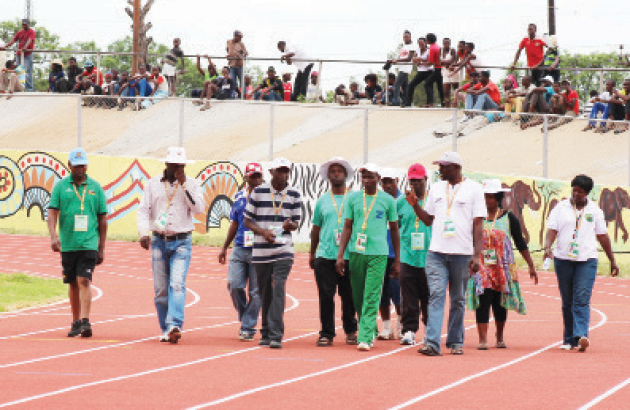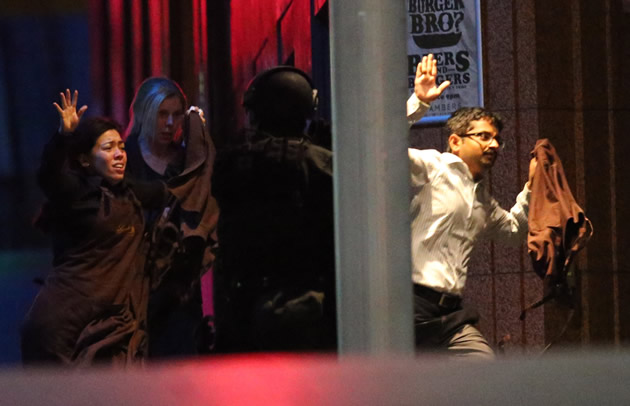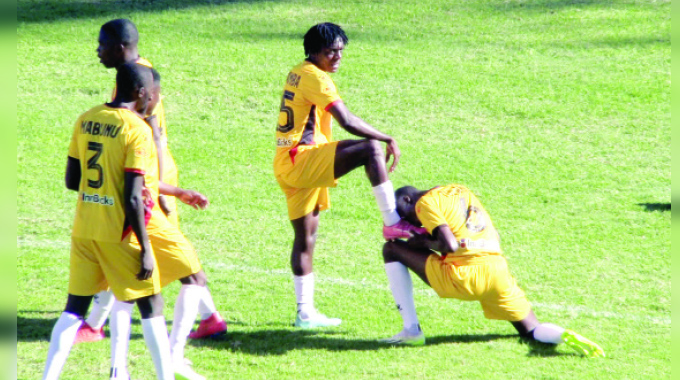New era for Zim athletics at White City


Athletics marshals take a look at the new tartan track before the resumption of the AUSC Region 5 athletics competitions at White City stadium earlier this month
Sports Reporter
A NEW era dawned for Zimbabwe athletics when the first official race was run on the new tartan track at White City Stadium on December 9.That ushered a new era and the crowds that came out to cheer athletes are expected to be a regular feature when the new season kicks off.
The day will remain entrenched in the history of Bulawayo and Zimbabwe athletics as the day when the first official race took place – the T11 800m of the sixth edition of the Africa Union Region 5 Games.
According to Moses Bhantsi, the chairman of the regional body, Zimbabwe invested in the latest in timing technology.
The Batswana veteran administrator said even some countries in Europe did not have the kind of equipment that was installed at White City Stadium.
Previously, White City was a run down cinder track that had long cried out loud for a state of the art surface for the benefit of athletes from the region.
Dwindling sponsorship had limited athletes to a few races on Harare’s tartan tracks at the University of Zimbabwe and National Sports Stadium. Both however did not seem to be of good use as more often there were no wind gauges and electronic timers to make recorded times authentic for one to qualify for major international events.
But on December 9 history was made when the first buzzer was blown to start the day’s proceedings to mark the historic opening of the facility.
Three hours later the Minister of State for Bulawayo Metropolitan Province, Nomthandazo Eunice Moyo, officially handed over the facility from government.
“This is the latest timing equipment. Some countries even in Europe don’t have what’s here. This is going to help the region develop, its athletes will be able to run here and qualify for major international events. This is a big legacy benefit not only for Zimbabwe but the region as a whole.
“We look forward to more competitions being held on this facility. Another advantage is the proximity to a number of countries who could easily drive to Bulawayo for competitions hoping to have their athletes qualify for major events such as the African Junior Championships, World Junior Championships and even the All Africa Games.
“The citing is good because this is where the people are. Fans have been able to walk to the stadium and break for lunch which is quite convenient,” said Bantsi.
In the past Zimbabwean athletes have relied on the Engen Series (South Africa), Yellow Pages (South Africa) and IAAF Permit Meetings for athletes to get qualifying standards for the All-Africa, African, Olympics and World Championships.
“We’re happy to have turned a new leaf in Zimbabwe athletics. This will benefit athletics and it will never be the same again,” said Tendai Tagara, the National Athletics Association of Zimbabwe president.
Among coaches who watched intently the opening proceedings at the magnificent facility, were Abel Manyumeka of Hwange, Vusumuzi Mlilo, Themba Mhlophe and Bhekuzulu Khumalo the technical director of the Games.
Triumph was written all over their faces as a long cherished dream had finally been achieved. For years the quartet has toiled on cinder, sandy and hard soil surfaces with some of the best athletes this country has produced.
But they never really got to see some of their most promising talent reach expected heights because of the prohibitive travel expenses to where there would be electronic timers and wind gauges.
Khumalo and Manyumeka were already coaches when in 1995 athletics lost out on an opportunity to have a tartan track laid at White City Stadium for the All-Africa Games.
“At long last we now have a facility that our local athletes will benefit from. It now challenges those involved in development to go to grassroots and start grooming talent for the future and make good use of the facility at our disposal. It’s an exciting development and we look forward to athletics benefitting a great deal from this,” said Khumalo.
Manyumeka who has spent close to 40 years with Hwange athletics and sport in general and worked with great names like Temba Ncube, Juma Phiri, Phillip Mukomana, Savieri Nghidhi, Benjamin Songoya, Adon Treva, Thethelani Ncube, Phineas Ajida, John Nkonde, Teurayi Chinguwa, Gabriel Chikomo and Phathisa Ngwabi, could not help but praise the decision to bring the Games to Bulawayo.
President Robert Mugabe played a key role in bringing the Games to Bulawayo after Zimbabwe was handed the baton to play host in 2012.
Manyumeka said now the challenge lay in the coaches’ hands and administrators to make use of the facility. He said athletics would grow in leaps and bounds after the hosting of the Games.
“We never had the opportunity to run on such facilities. We have toiled for years with generations of athletes and struggled to go to events in Harare and outside the country, for athletes in Matabeleland, the Midlands and Masvingo this is their chance to rise and shine. They will need more events on the great facilities so that they get used and try to attain qualifying standards for international competitions,” said Manyumeka.
Mhlophe praised the decision to have Bulawayo hosting the Games.
“Now we’ve a good facility that’s of high standard and I hope it will soon benefit athletics here and within the region,” said Mhlophe.
Bulawayo has been home to some of the finest athletes to emerge in Zimbabwe like 400m record holder Lewis Banda, triple jumper Ndabezinhle Mdlongwa, Norma Jean Harry, Caroline Ncube, Nobuhle Ncube, Juma Phiri who holds the high jump record of 2.16m and Mathias Kanda who ran in the Tokyo Olympics in 1964.
Hundreds of people were visiting White City during construction and as the marvel was beginning to take final shape with the laying of granules on the track and drawing of lanes, numbers increased.
Anyone passing past by car on December 6-8 would have thought the competition was underway as people from all over Bulawayo stopped by to take a glance at the beautiful facility.
Bantsi is confident that White City Stadium will be certified by the International Association of Athletics Federations to be considered as one of its accredited venues.
The certification would enable athletes who run or jump or throw qualifying standards to be considered for overseas scholarships and international events.
Now the ball is in the nation’s court for it to make good use of White City, retain it in its near perfect state for generations to come and also help brand the discipline which was once a good crowd puller and employer.
At one time athletics through the annual Chamber of Mines Track and Field Championships employed thousands of young men identified from schools’ sport.
For now children from Bulawayo and surrounding provinces will have access to a top of the art facility knowing that their efforts can land them national team stripes and scholarships.










Comments